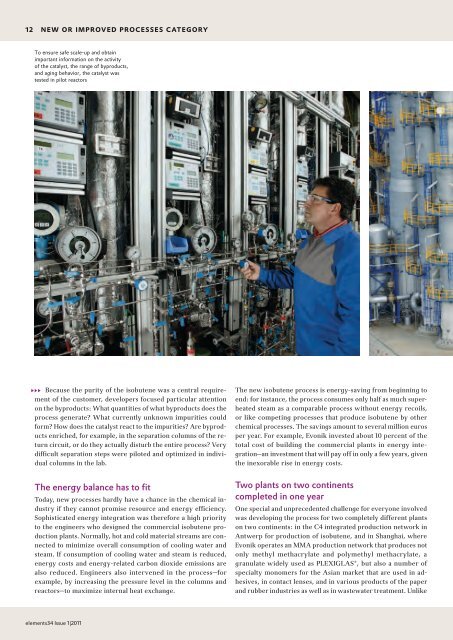Download - Evonik Industries
Download - Evonik Industries
Download - Evonik Industries
You also want an ePaper? Increase the reach of your titles
YUMPU automatically turns print PDFs into web optimized ePapers that Google loves.
12 neW or improved proCesses Category<br />
To ensure safe scale-up and obtain<br />
important infor mation on the activity<br />
of the catalyst, the range of byproducts,<br />
and aging behavior, the catalyst was<br />
tested in pilot reactors<br />
333 Because the purity of the isobutene was a central requirement<br />
of the customer, developers focused particular attention<br />
on the byproducts: What quantities of what byproducts does the<br />
process generate? What currently unknown impurities could<br />
form? How does the catalyst react to the impurities? Are byproducts<br />
enriched, for example, in the separation columns of the return<br />
circuit, or do they actually disturb the entire process? Very<br />
difficult separation steps were piloted and optimized in individual<br />
columns in the lab.<br />
The energy balance has to fit<br />
Today, new processes hardly have a chance in the chemical industry<br />
if they cannot promise resource and energy efficiency.<br />
Sophisticated energy integration was therefore a high priority<br />
to the engineers who designed the commercial isobutene production<br />
plants. Normally, hot and cold material streams are connected<br />
to minimize overall consumption of cooling water and<br />
steam. If consumption of cooling water and steam is reduced,<br />
energy costs and energyrelated carbon dioxide emissions are<br />
also reduced. Engineers also intervened in the process—for<br />
example, by increasing the pressure level in the columns and<br />
reactors—to maximize internal heat exchange.<br />
elements34 Issue 1|2011<br />
The new isobutene process is energysaving from beginning to<br />
end: for instance, the process consumes only half as much superheated<br />
steam as a comparable process without energy recoils,<br />
or like competing processes that produce isobutene by other<br />
chemical processes. The savings amount to several million euros<br />
per year. For example, <strong>Evonik</strong> invested about 10 percent of the<br />
total cost of building the commercial plants in energy integration—an<br />
investment that will pay off in only a few years, given<br />
the inexorable rise in energy costs.<br />
Two plants on two continents<br />
completed in one year<br />
One special and unprecedented challenge for everyone involved<br />
was developing the process for two completely different plants<br />
on two continents: in the C4 integrated production network in<br />
Antwerp for production of isobutene, and in Shanghai, where<br />
<strong>Evonik</strong> operates an MMA production network that produces not<br />
only methyl methacrylate and polymethyl methacrylate, a<br />
granulate widely used as PLEXIGLAS®, but also a number of<br />
specialty monomers for the Asian market that are used in adhesives,<br />
in contact lenses, and in various products of the paper<br />
and rubber industries as well as in wastewater treatment. Unlike

















